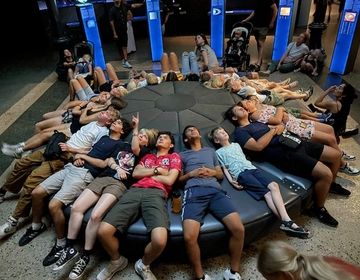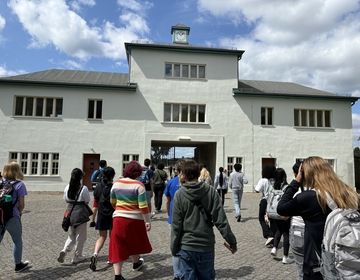Three Days in Joburg
I am writing to you after three jam-packed, powerful and informative days in Johannesburg. Not only was it awesome to have time to overcome jet lag and get our first taste of South African culture, but it was also important that we began our introduction to the history of apartheid and Mandela’s legacy in South Africa's largest city.
Our time in Johannesburg, or Joburg as the locals call it, started off with a huge surprise! While enjoying breakfast at our hotel we looked out the window and saw that it was snowing! For many of us coming from sweltering temps in summer months, it was a intense reminder that it is winter here! The snow got mixed reactions from the students, but it was lovely to see the smiles on the faces of the local staff, many of whom have not seen snow.
Interspersed between a few sessions of orientation where we learned about what we needed to do to keep ourselves healthy, safe, and secure while on the program, we visited Constitution Hill, the township of Soweto and the Apartheid Museum.
On Monday, we visited Constitution Hill, a living museum that tells the story of South Africa’s journey to democracy. There we saw the former prison and military fort and learned about South Africa’s turbulent past. It was difficult to see the cells where Winnie and Nelson Mandela, along with other political activists were kept but inspiring to learn how the space is being used today to uplift human rights. Along side the museum is the site of the country’s current Constitutional Court, a space filled with intentional art that traces South Africa's roots, and a place which endorses the rights of all citizens.
The next day we visited the Soweto, which stands for Southwestern Township. Our first stop was the Hector Pieterson Museum where we learned about the Student Uprising of 1976. For our students, who face social justice issues and fight for equality every day in their home communities, this was an especially powerful exhibit. After the memorial, we visited Nelson Mandela‘s house on Vilakazi Street, which is also the site of Archbishop Desmond Tutu's former residence, making it the street with the highest concentration of Nobel Peace Prize winners.
During our tour of Soweto we got to visit several neighborhoods and learn about the segregation of South Africans along racial and economic lines, which still exists today. Our tour ended with a local lunch where we tried steamed bread, pap (grits), meat stew, and a South African sodas. After lunch we were treated to a singing performance and a dance party.
On our last day in Johannesburg visited the Apartheid Museum. Sadly, we only had two hours there, which was not nearly enough to see everything, but the time we spent was a powerful reminder of the context under which we will be performing our service in Cake Town. Our students were drawing several parallels between the Apartheid resistance and the Civil Rights Movement in the U.S. The museum was a sobering experience but one that I am grateful for, as it led to many interesting conversations between the students about police brutality, prison reform, and the concept of Ubuntu, recognizing one's humanity. Our time in Johannesburg has primed us for our time in Cape Town and I know our students are looking forward to arriving, unpacking their bags for good, and seeing where we will be experiencing local culture for the next 2 1/2 weeks. I will be sure to update you when we get there!
Related Posts
Museum für Naturkunde Excursion
Berlin Language & Culture students visited the Museum für Museum für Naturkunde – Leibniz-Institut für Evolutions- und Biodiversitätsforschung (Museum of Natural History – Leibniz Institute for Evolution and Biodiversity Science)... keep reading
Exploring the Reichstag Dome
On Monday, students from the Language and Culture program had the opportunity of visiting the iconic dome atop the Reichstag, the seat of Germany’s federal parliament (the Bundestag). As they... keep reading
Sachsenhausen Memorial Visit
On Wednesday, students of the Language and Culture program visited the Sachsenhausen concentration camp. Students were very interested in learning about the history of the camp and how it came... keep reading


